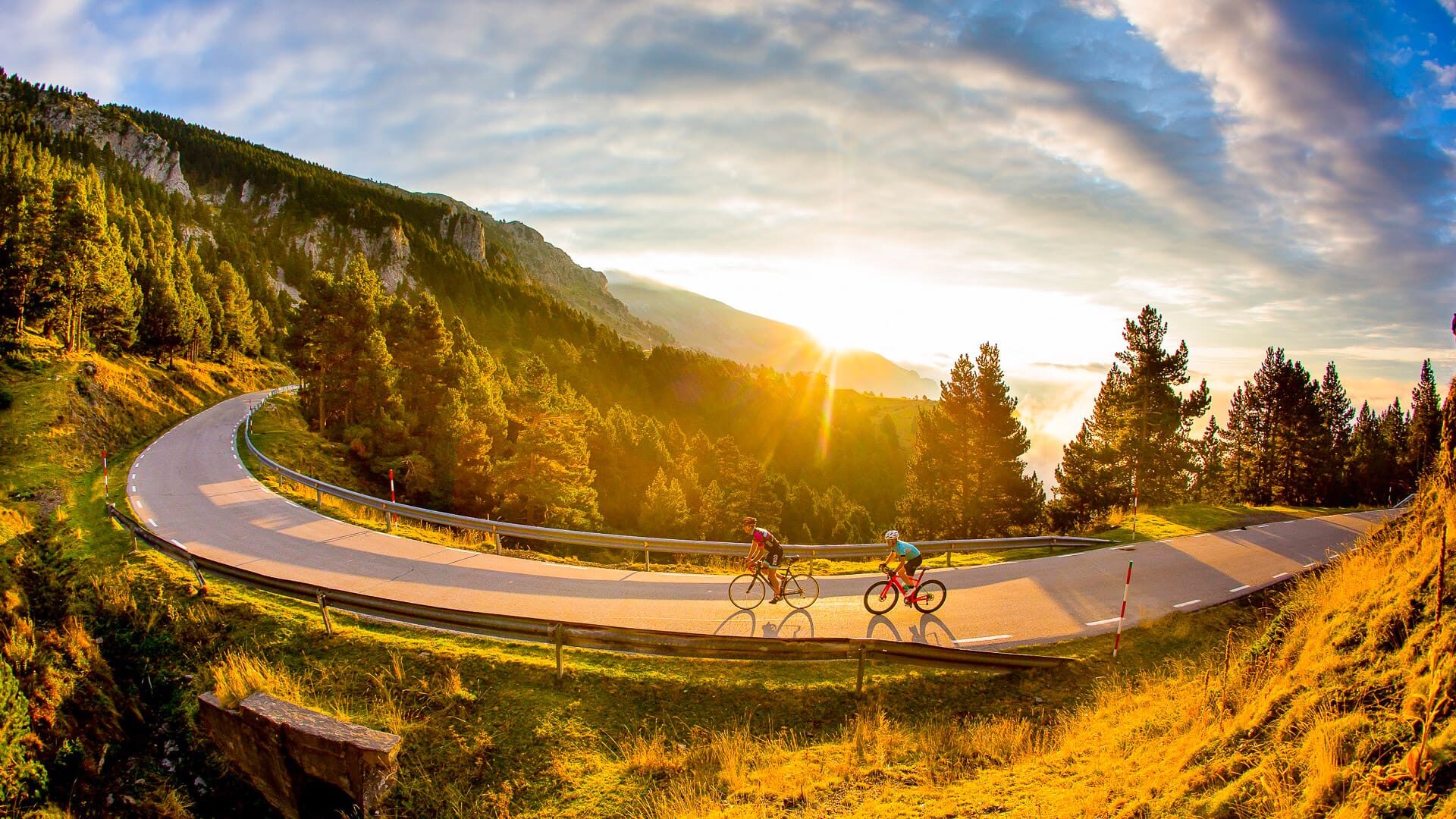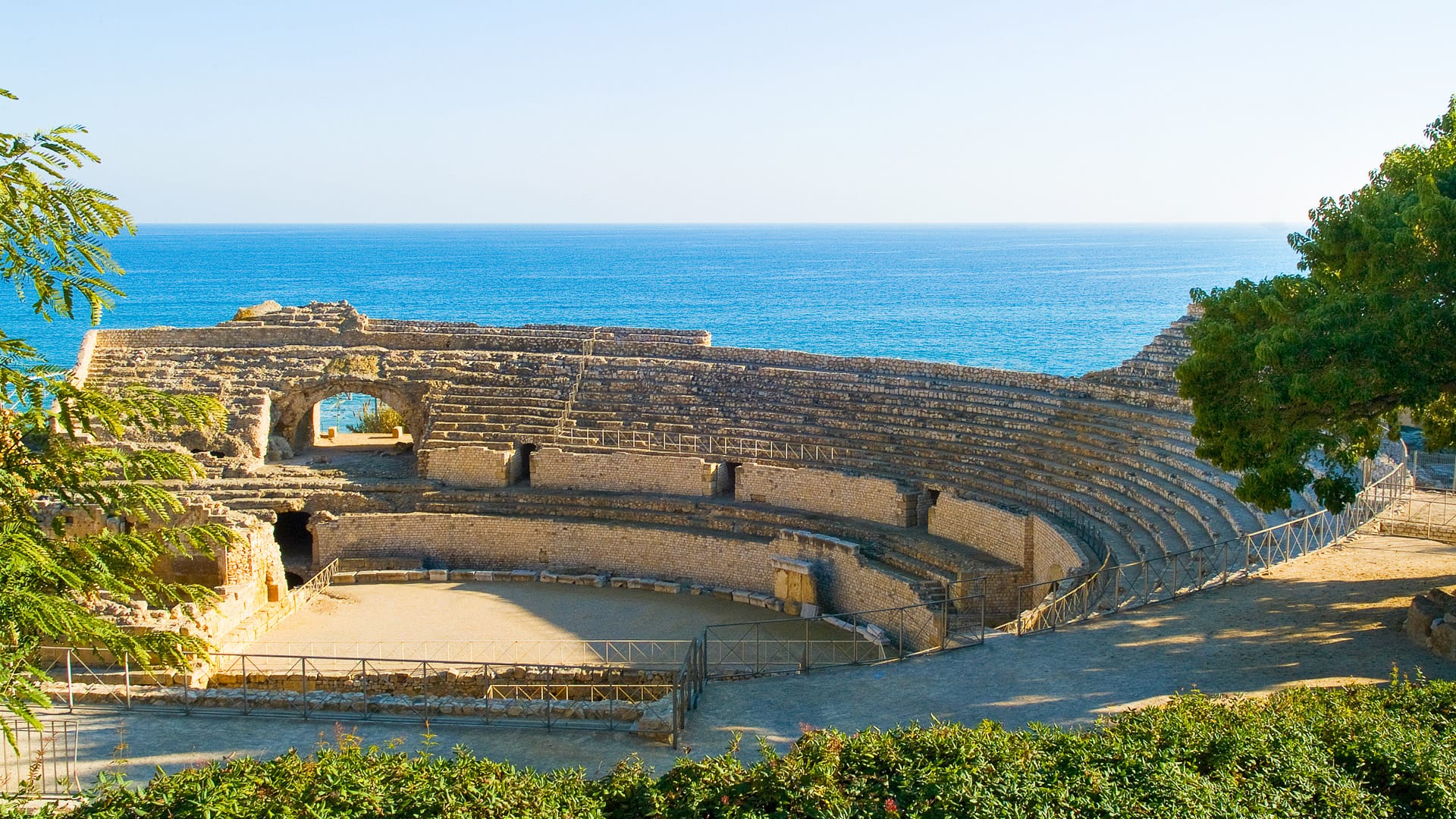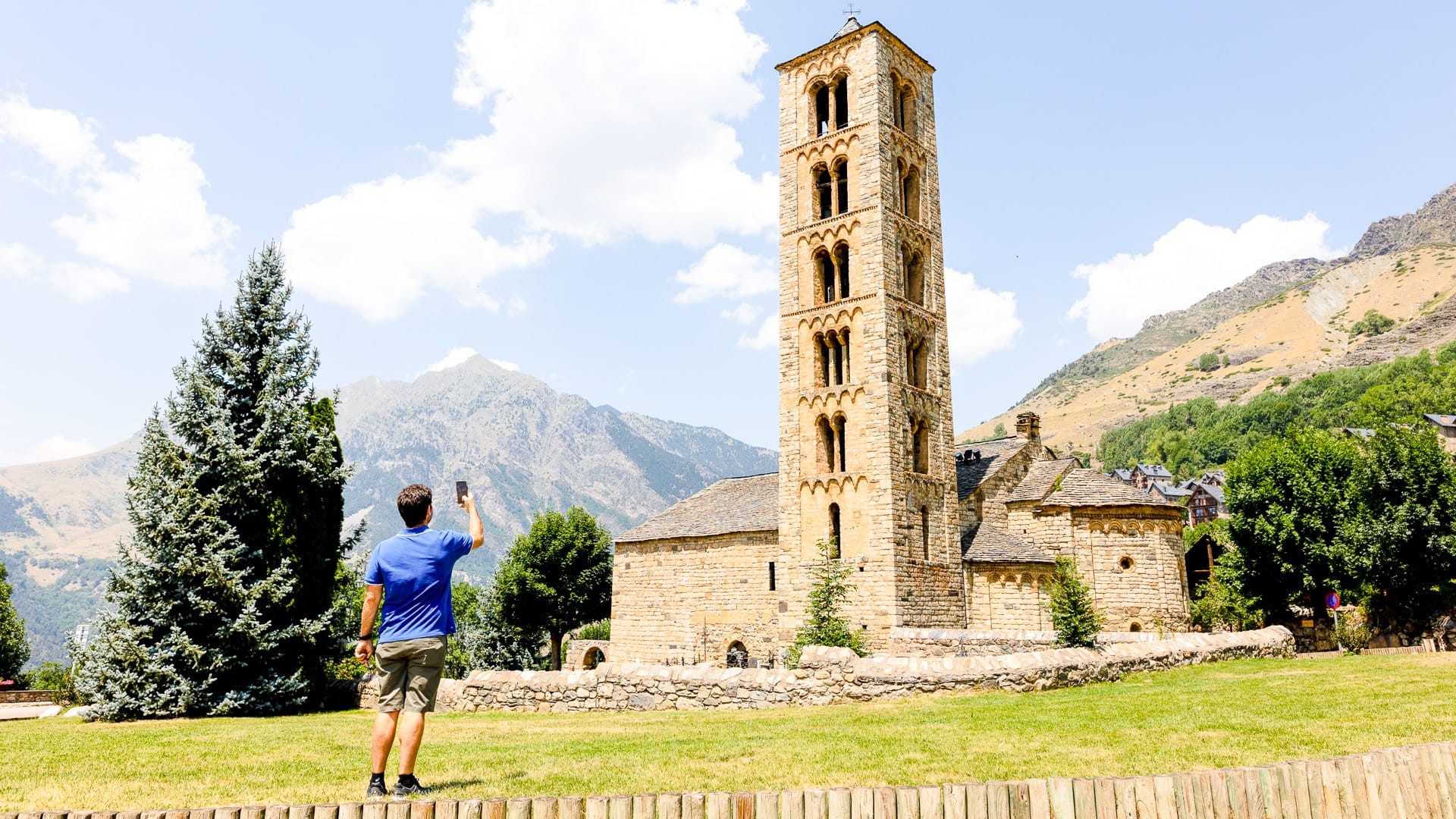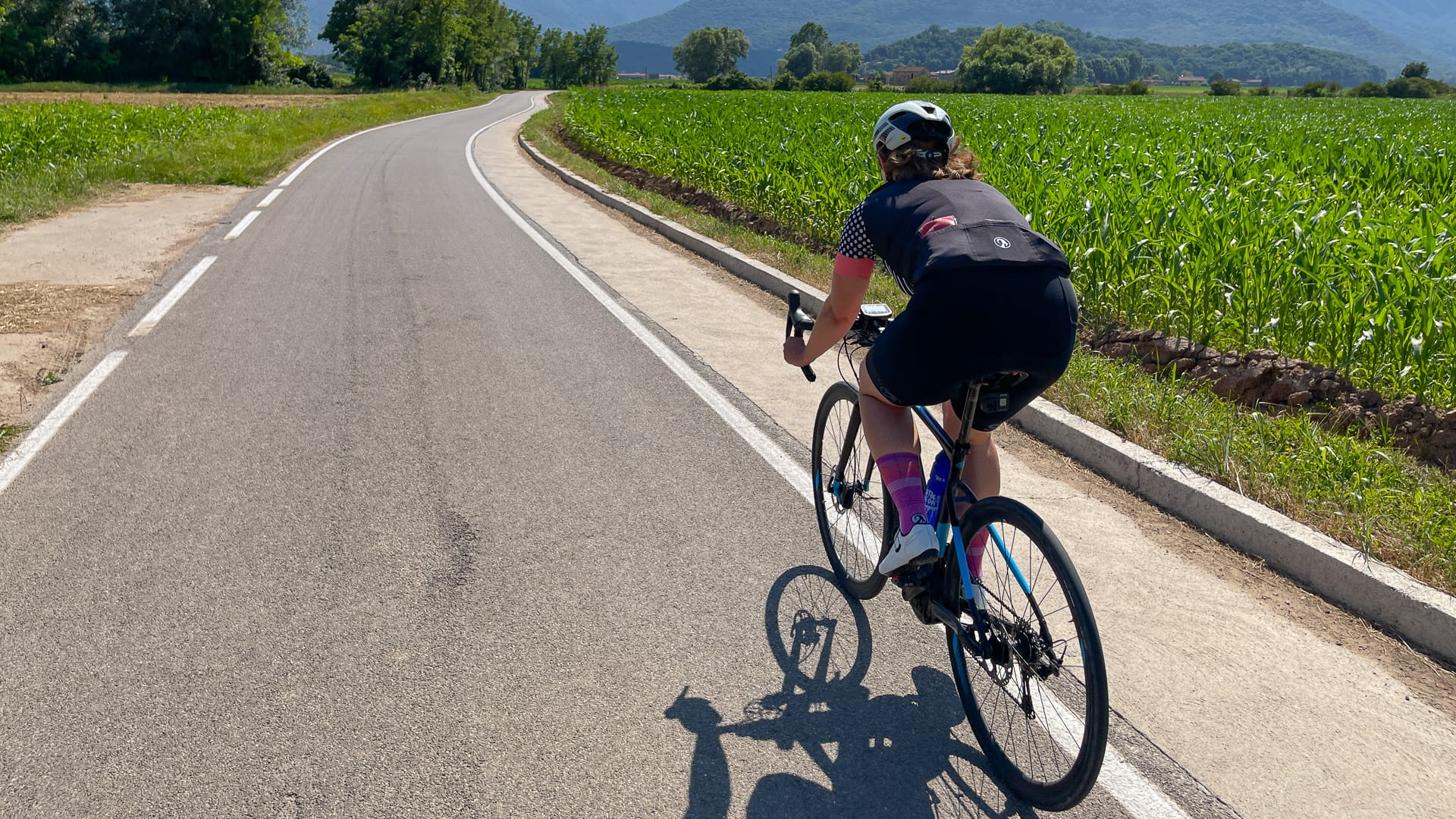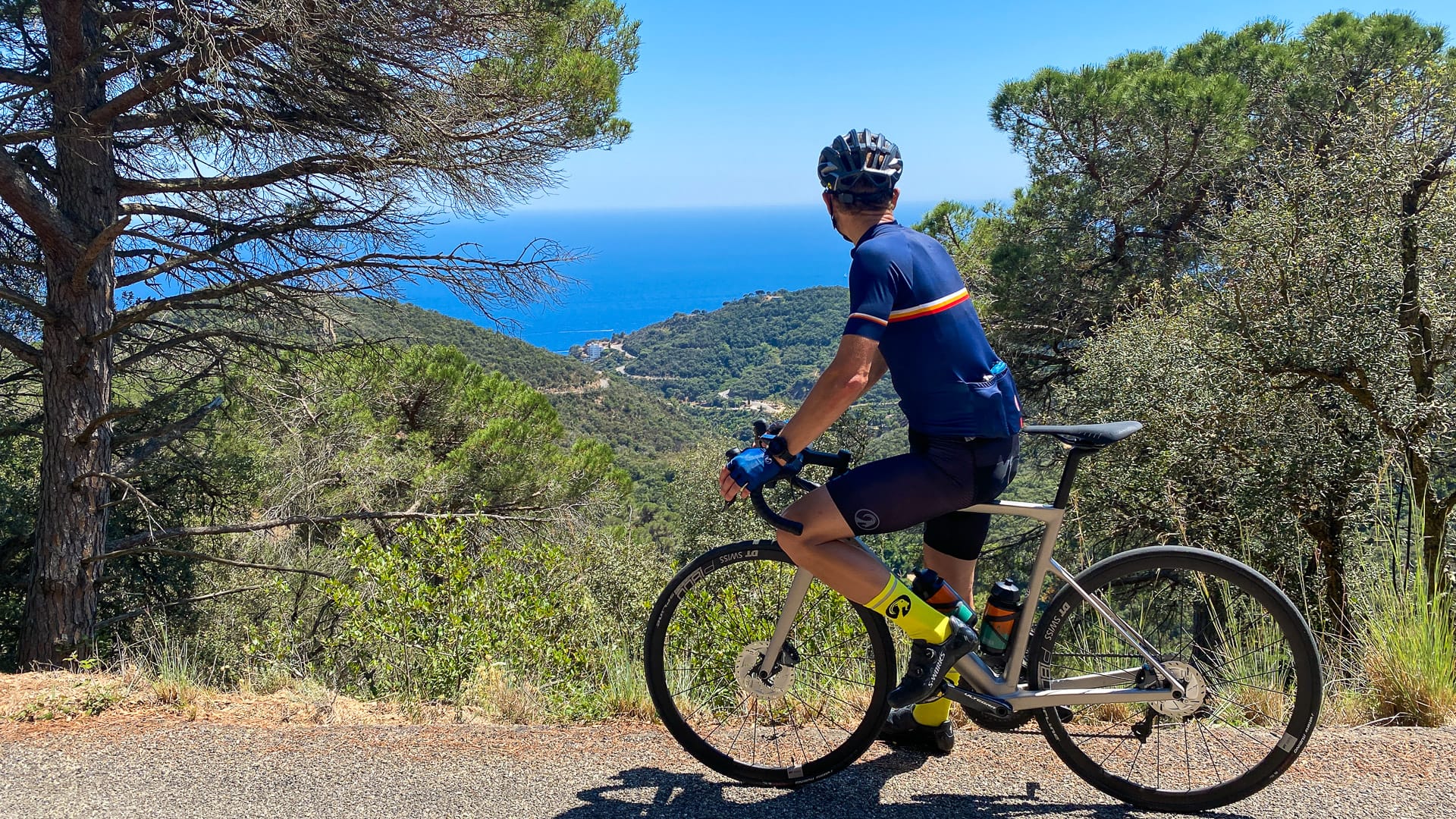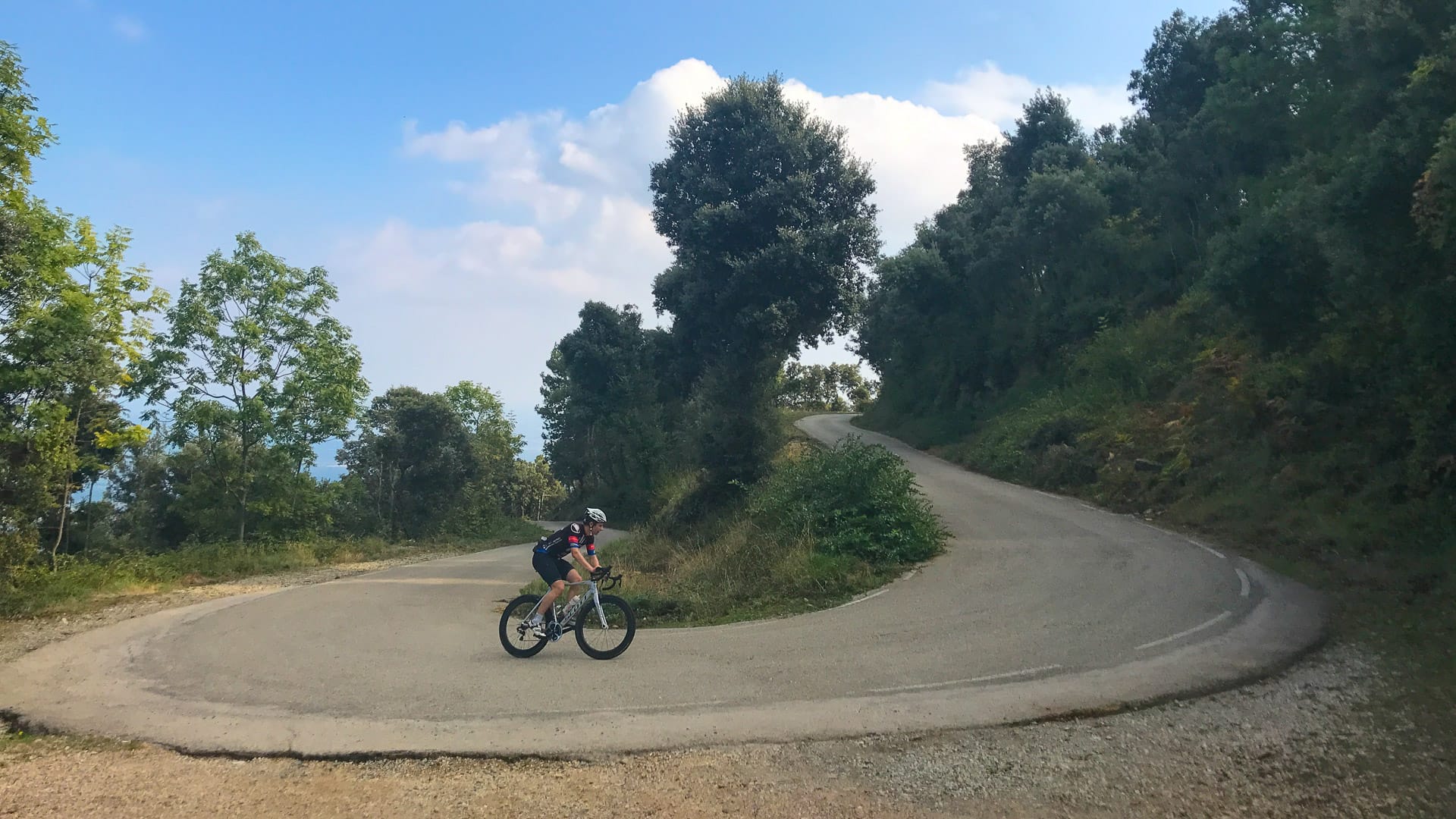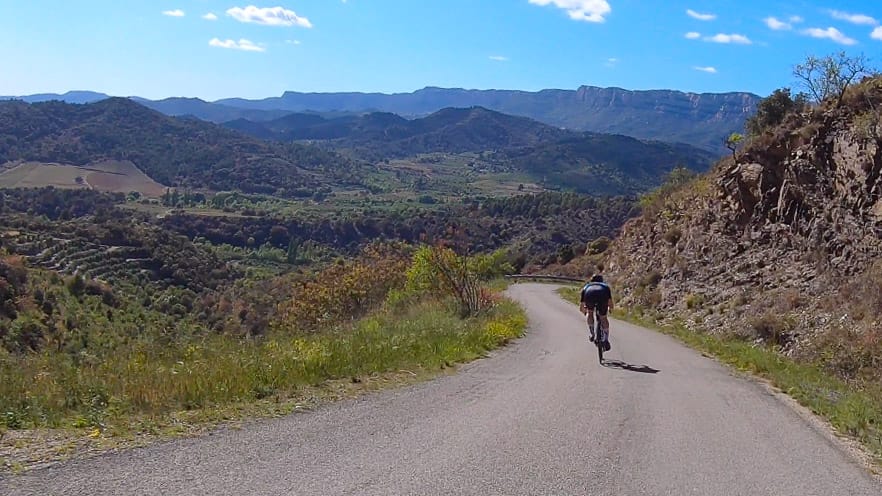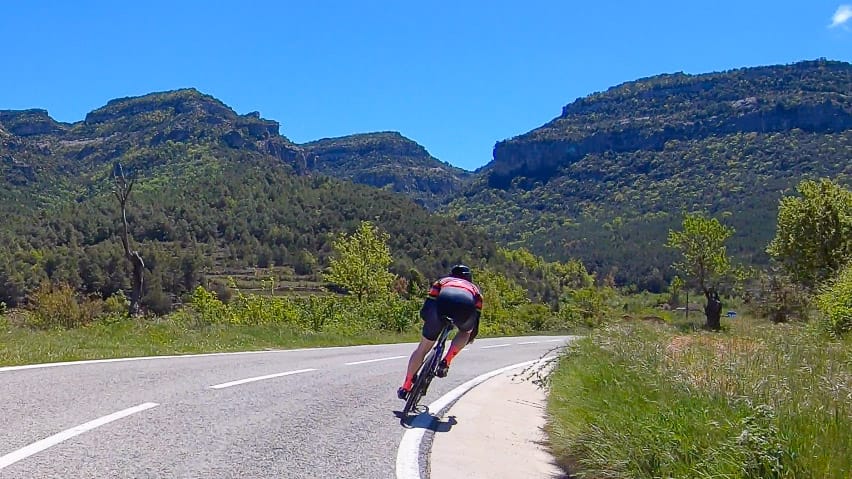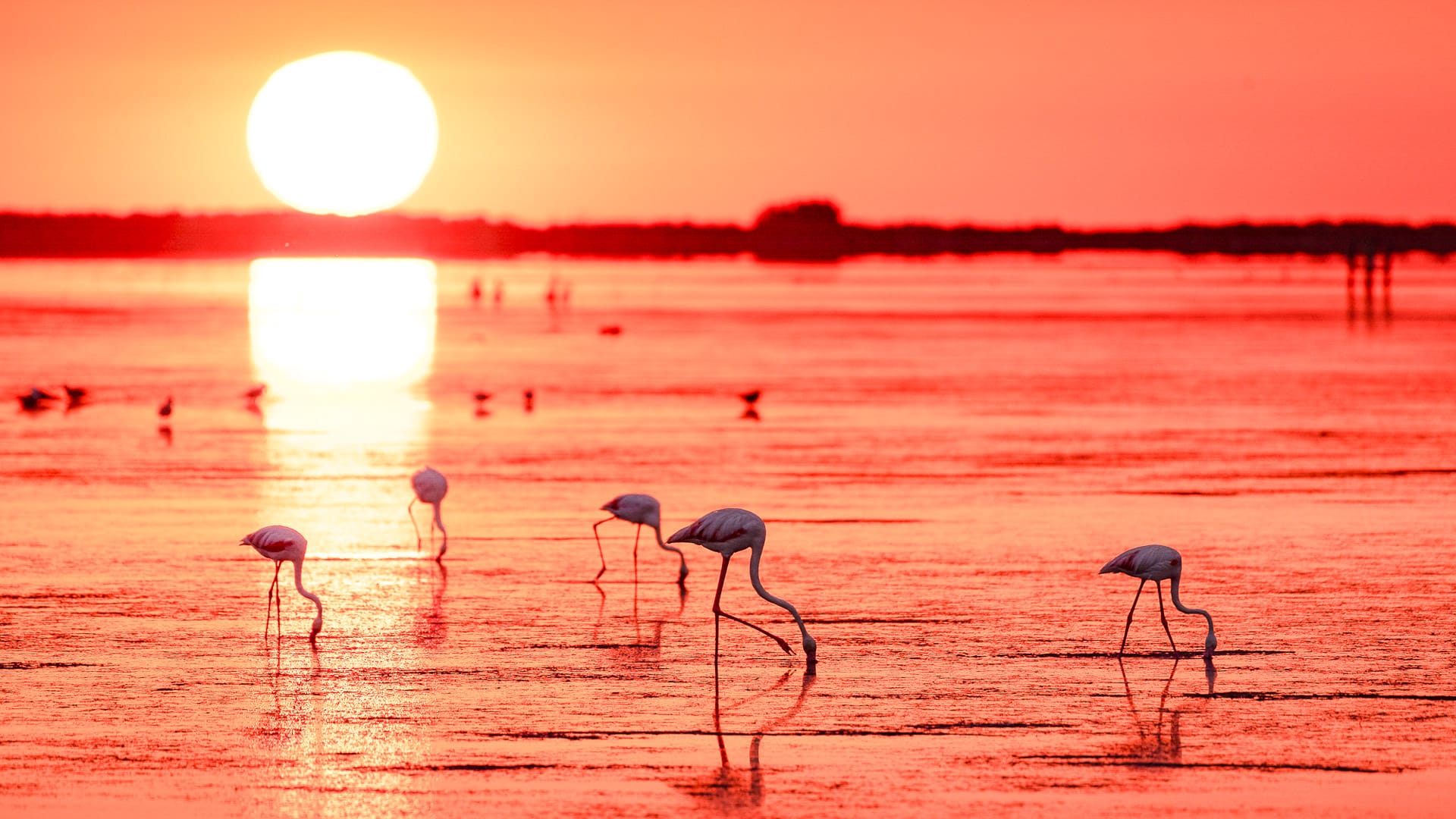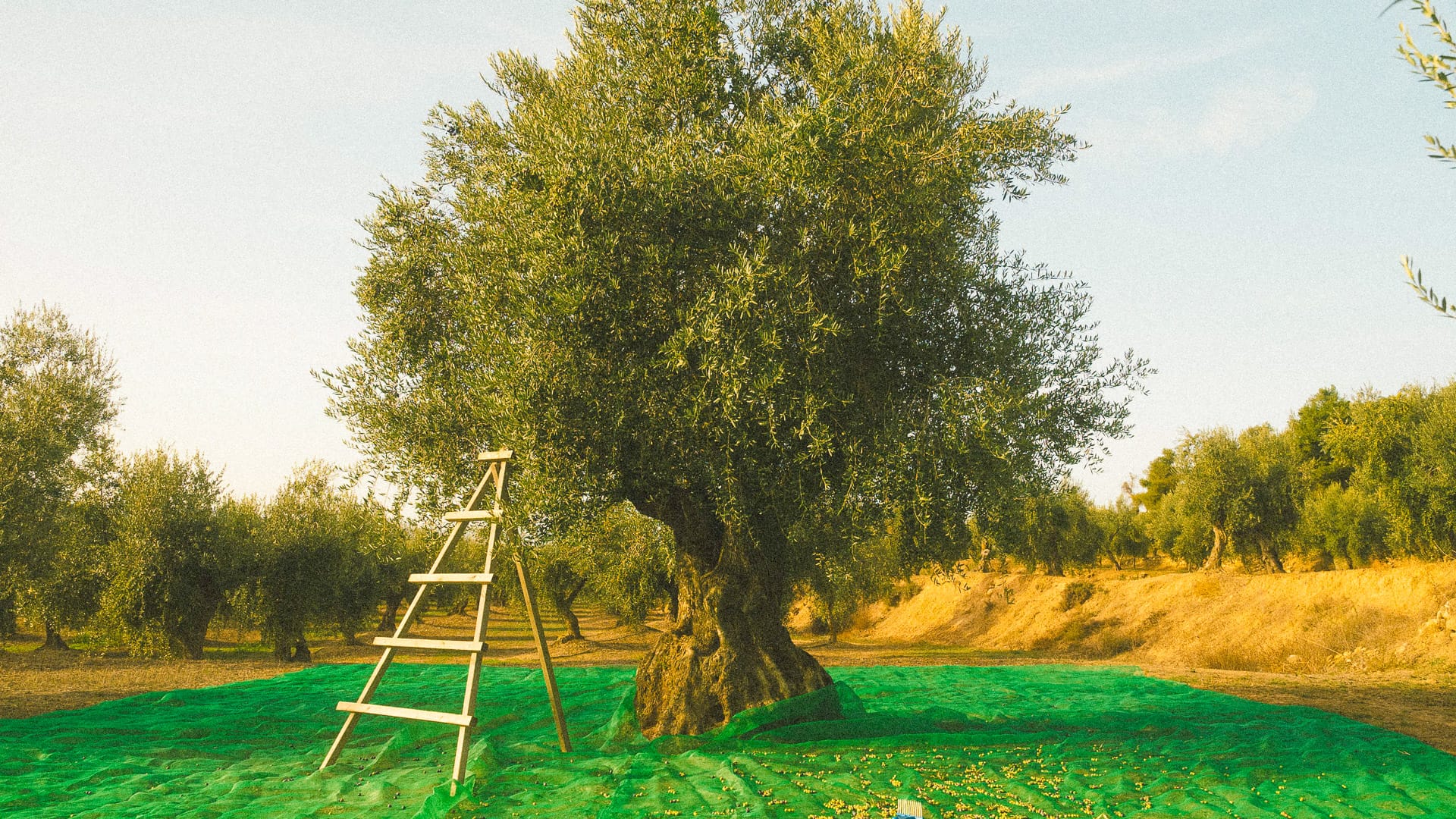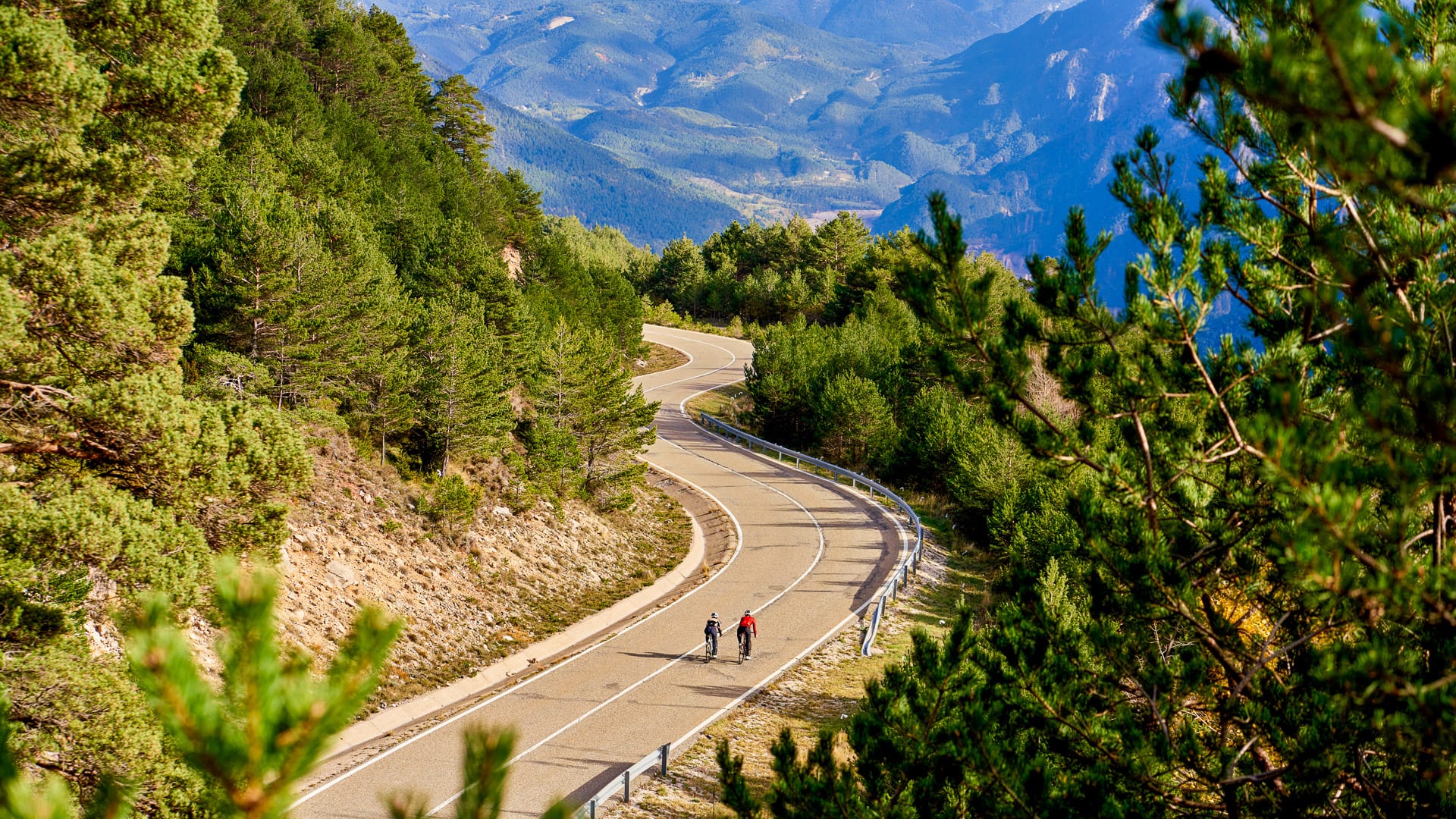Cycling in Catalonia ticks every box: long sunshine hours, superb coffee stops, and a cycling culture where group spins, club routes and pro squads are part of the daily scenery.
Add terrain that pivots from high Pyrenean passes to coastal lanes with a Mediterranean Sea backdrop, and you’ll see why it’s on so many riders’ wish lists.
Girona is the most famous crowd pleaser and offers easy logistics, buzzing bike cafés and access to headline climbs. But point your wheels south (and also west) and the tempo changes dramatically: you’ll find big horizons, authentic, sleepy towns and empty roads that feel a world away from the tourist trail.
I’ve visited the region several times and logged hundreds of cycling miles here in recent years. I’ve also interviewed several local experts to get under the skin of what makes Catalonia so special for cyclists. So, when Catalonia – Catalan Tourist Board asked us to create this overview of cycling in Catalonia as an explainer for those wondering how the region fits together, I was delighted to help.
Bonus: Catalonia is the 2025 World Region of Gastronomy. This makes it a dream destination for cyclists who love to refuel on great food. The region will also host the Tour de France Grand Départ in 2026!
This guide explains how Catalonia fits together from a cyclist’s perspective and where to head for what kind of cycling. Note we focus on Catalonia within Spain, rather than French Catalonia, which falls within the French département of Pyrénées-Orientales.
Here are the key Catalonia destinations we already cover in separate guides and which we draw together here:
The guide is jam-packed with tons of useful information. So, to help break it down, we’ve split this article into multiple parts. This includes:
- Part 1: Why should cyclists visit Catalonia? For my take on the region’s top highlights.
- Part 2: Please can you give an overview of Catalonia from a cyclist’s perspective? Where Catalonia is located and a brief overview of each of its regions.
- Part 3: What are the best places to cycle in Catalonia? The best regions and Catalonia rides to consider.
- Part 4: What do you need to know before going on a cycling holiday in Catalonia? Practicalities and tips to help you prepare for a Catalonia cycling tour.
- Part 5: Where can cyclists find out more about cycling in Catalonia? Details on useful links for more information.
Part 1: Why should cyclists visit Catalonia?
Catalonia is where many pros choose to base themselves. But whilst Girona often grabs the headlines, wider Catalonia is the real prize.
You get bright skies, quiet roads and mountains that rise fast from the coast. Cafés know cyclists, the food’s excellent and the post-ride scene is relaxed.
Where is Catalonia located?
Catalonia sits in the northeast of Spain, with France and Andorra to the north, Aragón to the west, Valencia to the south, and the Mediterranean Sea to the east.
Catalonia’s capital is Barcelona, and the region spans four provinces: Barcelona, Girona, Lleida and Tarragona.
Below is a map of the region, which includes several places featured in this article. Hover over the map pins to see the names of places.
Dramatic landscapes
Catalonia squeezes a lot onto a (relatively) small map. The shoreline flows over soft rises with beautiful sea views, while the plains thread you through farm tracks and vine-striped lanes. Nudge inland and the hills arrive quickly; keep going and the Pyrenees give you long, honest climbs and wide-open descents.
That variety makes planning easy. Take an easy spin beside the water, stitch together vineyard backroads for a mellow day, or head up into the foothills when you fancy more elevation. There are sheltered valleys for breezy days and flatter links for recovery. It’s terrain that builds form without battering you day after day.
Discover more about Catalonia’s diverse regions and terrain below.
Cycling culture
From Barcelona’s everyday bike life to the region’s well-known climbs, cycling is woven into Catalonia.
For example, Barcelona is investing in bike lanes (source)and Bicing bike-share (source), making exploring on two wheels increasingly accessible. Girona draws in plenty of pros to take on famed climbs such as Els Àngels and Rocacorba; this, in turn, fuels its café-and-workshop buzz. Down the coast, the Costa Daurada blends vineyard backroads with big days in the Prades; inland, Terres de Lleida offers castle-topped villages and calm Pre-Pyrenean climbs.
Further south, Terres de l’Ebre is a treat to ride. Drivers are used to cyclists and typically patient; the asphalt is smooth, small roads are plentiful, and it’s easy to stitch together quiet loops. For traffic-free cycling, the Zafán Valley Greenway (Via Verda Val de Zafán) runs 180 kilometres from Aragón to Tortosa on a disused railway is also a great option to consider. Inside the Delta de l’Ebre Natural Park, well-signposted routes and downloadable maps also make navigation easy.
Add in region-wide routes like the Pirinexus gravel loop and bucket-list fixtures such as the Volta a Catalunya and Sea Otter Europe, and cycling here feels normal, not niche. Find out more about Catalonia’s events below.
Rich local traditions
Catalonia’s culture is lived-in, not staged. Catalan sits alongside Spanish on signs; most adults can speak it, so a cheery “bon dia” lands well.
In April, Catalonia’s cities, towns and villages fill with books and roses to celebrate Sant Jordi, the patron saint of Catalonia. In September, the harvest season ends, opening the door to many harvest festivals across Catalonia’s wine regions, bringing together family, friends, and new wine. Across many towns, you’ll also see human towers (known locally as castells), now on UNESCO’s Intangible Heritage list (source).
Head inland and you will find a quieter and more unique side of Catalonia.
For example, the region of Lleida stays off most itineraries, which means light traffic, a proudly Catalan atmosphere and the kind of warm, down-to-earth welcome that turns a coffee stop into a conversation. You’ll roll through traditional villages and characterful towns, including Solsona and Lleida. Here, plazas are unhurried and menus feature local flavours, including Les Garrigues olive oil, PDO Lleida pears and PGI Veal of the Catalan Pyrenees. Find out more below.
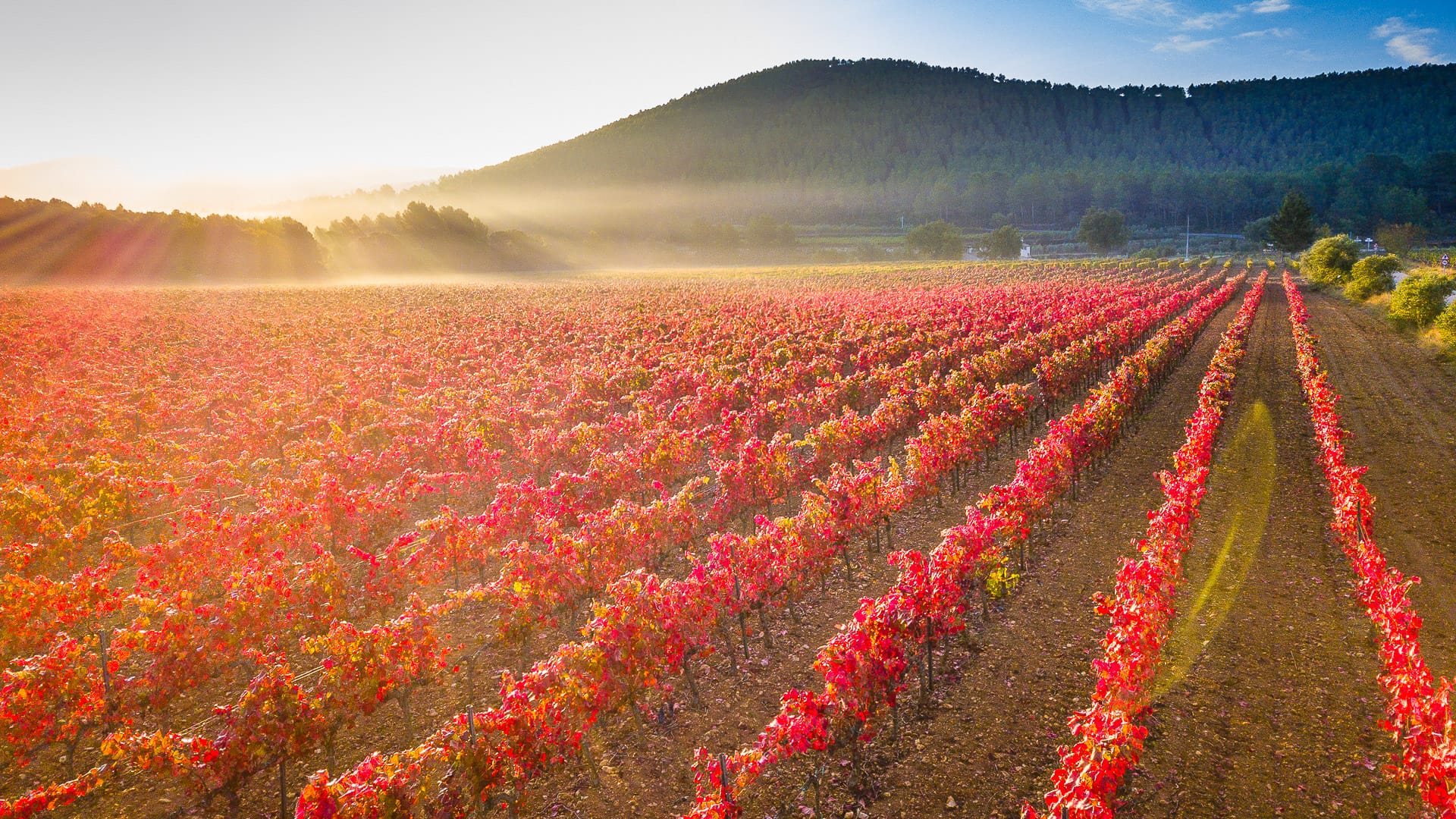
Autumn vineyards (photo credit: Rafa Pérez via Catalonia – Catalan Tourist Board)
Part 2: Please give an overview of Catalonia from a cyclist’s perspective?
What are Catalonia’s 4 provinces – and what do they offer cyclists?
Barcelona (including Costa Barcelona, Barcelona Landscapes and Barcelona City)
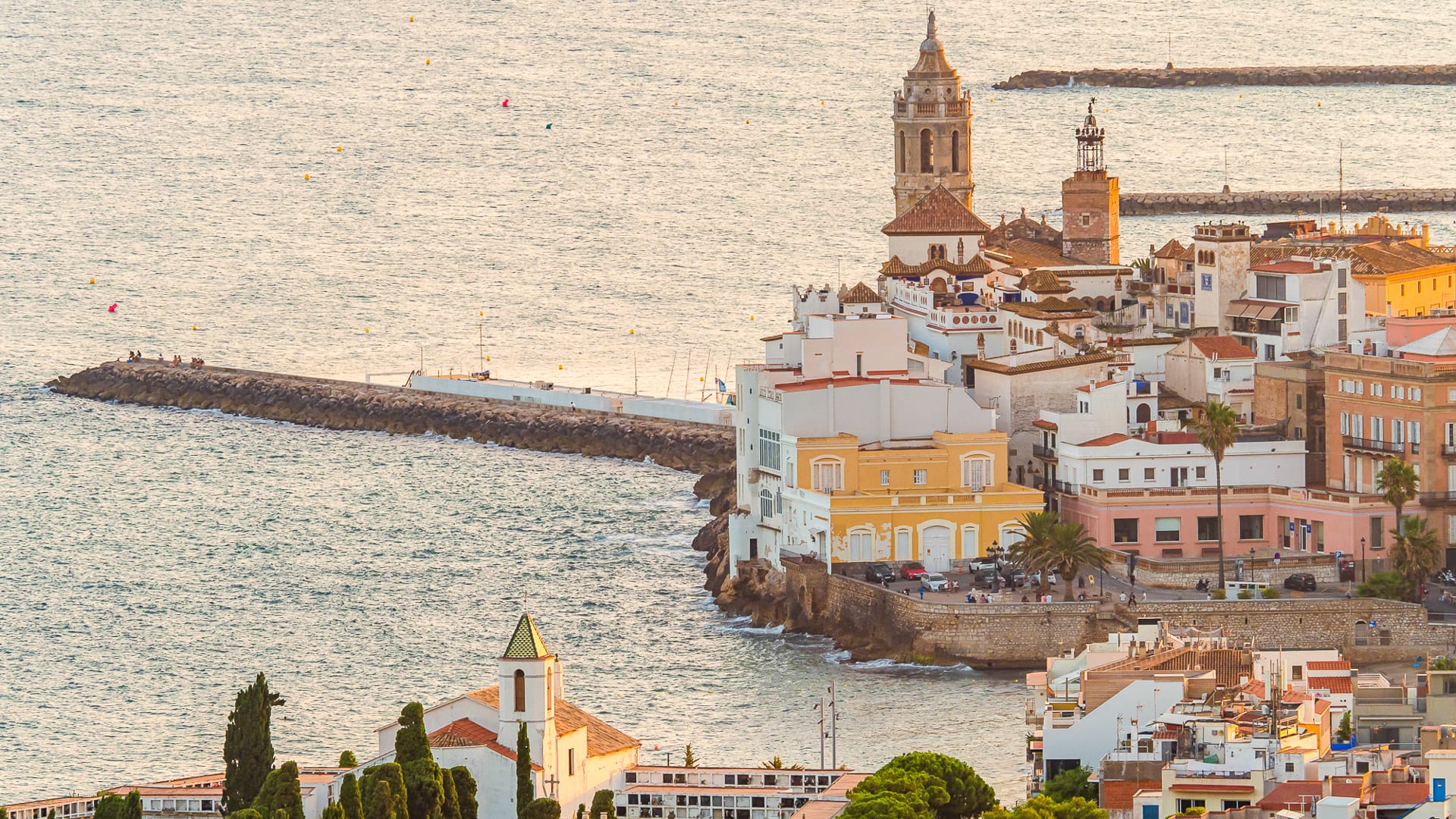
Sitges seafront and church in Costa Barcelona (photo credit: Maria Rosa Vila via Catalonia – Catalan Tourist Board)
Barcelona packs coast-to-peaks variety into a compact radius. Coastal plains rise into protected hills with climbs and sea views, including Collserola, Garraf, Serralada de Marina, and Montnegre i el Corredor.
Inland basins like Vallès, Penedès, Bages and Osona link vineyard lanes to signature massifs that punctuate the skyline, including Montserrat and Montseny. Further north, Berguedà brushes the Pre-Pyrenees for even bigger climbs of over 2,500 metres of elevation gain.
Discover more about where to cycle in Barcelona below.
Girona (including Costa Brava – Girona Pyrenees)

Girona’s colourful buildings and a Catalan flag proudly flying
Inland from the city lie lakes, castles and quiet countryside. There’s a great variety in short rides out from the city, which suits time-poor riders.
The coast pairs lively towns with easy escapes into rolling countryside. Girona offers boutiquey, post-ride buzz, while rural lanes deliver calm spins or structured sessions.
Discover more about where to cycle in Girona below.
Tarragona (including Costa Daurada and Terres de l’Ebre)

Cycling Poblet (photo credit: Ziklo Team via Catalonia – Catalan Tourist Board)
In the Costa Daurada, Roman ruins and coastal blue meet olive groves and low mountains. It’s a lovely base if you want a mix of culture and steady climbing.
Down by the Ebro delta, you’ll find beaches and wetlands alive with birdlife. Don’t be fooled by the seascapes. Mont Caro rises steeply above it all and tests any rider.
Discover more about where to cycle in Tarragona below.
Lleida (including Terres de Lleida, Val d’Aran and the Pyrenees)

Scenic roads on the Bonaigua Pass (photo credit: Torisme Val d’Aran)
The province of Lleida includes the Val d’Aran and Terres de Lleida. Up in Val d’Aran, the mountains close in. Climbs are long, home to gravity-defying switchbacks and long efforts. The scenery is “big” and the air feels crisp. Nearby Catalan Pyrenees roads thread through forests and high valleys with little traffic.
Further south, Terres de Lleida softens. Expect rolling vineyards, river valleys and hill towns. It’s easier on the legs yet still rewarding.
Discover more about where to cycle in Lleida below.
Part 3: What are the best places to cycle in Catalonia (the best bases and Catalonia cycling routes)?
Barcelona
Barcelona tops city-break shortlists, but the riding that spreads out around it is the real surprise. Within a compact radius, you get a patchwork of landscapes, reliable weather and easy travel, which makes planning simple and days on the bike a joy.
East of Barcelona
East of the city, Maresme’s shoreline strings together quiet winter roads, forested hills and snaking coastal tarmac; the sea and mountains sit so close that you can roll from beach cafés to the folds of Montseny in a single outing.
West of Barcelona
To the west, El Penedès opens into vineyard country. Vilafranca del Penedès lies roughly 60 kilometres from the city and works well as a calm, low-stress base for easier miles.
Northeast of Barcelona
Push northeast and Osona centres on Vic, around 70 kilometres from Barcelona. History frames the town square; the riding fans out towards the north face of Montseny and into the uplands of Collsacabra and Les Guilleries, where views stretch and the gradients keep you honest.
Further inland, El Berguedà concentrates challenges. Berga sits about 100 kilometres from the city, and the surrounding ridgelines cram in a dozen serious climbs within a small area – they are steep, rewarding and memorable.
Why cyclists love it
Layer in Mediterranean forests, Romanesque chapels, vineyard lunches and the region’s food and wine, and you’ve got a destination that suits mixed groups as well as focussed riders. Add a cultural day in Barcelona to keep everyone happy, or treat the city as your bookends: arrive, ride, then celebrate back among the city’s medieval lanes and famous sights.
Top tip! For visiting cyclists, the wider Barcelona region is better than its city-focused reputation suggests – it’s varied, reachable and surprisingly peaceful once you’ve got beyond the ring roads.
Suggested route: La Ruta Minera (the mining route)
GPX DownloadTerms of use reminder
Start and finish in Berga on a demanding tribute to the region’s mining heritage: roughly 125 kilometres with 3,000 metres of climbing, linking six passes, including Coll de la Mina, Coll de Port, Coll de Josa, Coll de la Trapa, Coll del Pradell and Coll de Fumanya.
Expect long, steady ascents, wild scenery and sweeping descents past the La Josa del Cavall reservoir, with classic stops in Sant Llorenç de Morunys, Tuixent and Gòsol beneath Pedraforca. It’s a bucket-list day for experienced riders looking for a big day out on the bikes!
More information
- Interested in this Barcelona cycling route? Find more details in this guide.
- Guide to cycling in Barcelona, for an in-depth overview of this region.
Girona
Wander Girona and two sets of people catch the eye. Film fans trace Game of Thrones locations around the cathedral and old stone lanes, while riders in casquettes and sporting crisp tan lines sip espresso beside neatly parked bikes.
Why cyclists love it
The place just clicks for cyclists: culture at every turn, a mild climate, and routes that fan out in all directions. Within a short spin you’re rolling northwest into the Garrotxa around Olot or southeast to the Gavarres and the Costa Brava for cliff-top views and curving coastal roads.
The terrain is varied rather than extreme; smooth asphalt, steady climbs, forest lanes and Costa Brava rollers that link pretty coves and headlands. The coffee is also first-rate, restaurants welcome cleats, and bike hire, guiding and workshop support are easy to sort.
A thriving cultural hub
Between rides, or as a day trip, Girona is a delight. City walls, stairways and river bridges frame evening strolls; festivals and markets add colour across the year.
In the centre, accommodation includes many boutique hotels that are great for couples and small groups. If you’re part of a bigger group or want space and a calmer vibe with easier access into rural areas, choose bases just beyond the old town. Places like Lake Banyoles and coastal villages like Tossa del Mar are worth a look.
Add it up and the appeal is clear: a compact, bike-savvy city with the Costa Brava on its doorstep and plenty to enjoy off the bike.
Suggested route: Cycling Costa Brava (Via Sant Grau)
GPX DownloadTerms of use reminder
Start and finish in Girona, riding a coastal loop via Llagostera and Tossa de Mar before climbing Sant Grau and returning inland to Girona. Expect roughly 95 kilometres with about 1,300 metres of elevation gain.
The draw is classic Costa Brava: long, friendly gradients, fast, sweeping descents and that glorious rollercoaster road between Tossa and the Sant Grau turn-off. The Sant Grau climb (6.3 kilometres at approximately 5% gradient) serves up big panoramas, then a flowing drop back towards Llagostera. Think smooth tarmac, light traffic and constant views of craggy red cliffs, green pines and turquoise coves!
More information
- Interested in this Girona cycling route? Find more details here.
- Guide to cycling Girona
- Best Girona cycling climbs
- A 72 hour cycling holiday in Girona
- Easy cycling routes in Girona
Tarragona
1. Costa Daurada in a nutshell
The Costa Daurada is a golden coastal strip in Tarragona with 81 kilometres of Mediterranean shoreline. Resorts, quiet fishing harbours and Roman heritage set an easy rhythm.
Roll inland and the landscape sharpens; cliffs, protected parks and sleepy villages link together on a mesh of more than two thousand kilometres of low-traffic roads.
Costa Daurada is the place to build steady coastal spins, or head inland for tougher gradients and testing climbs before dropping back to the sea for recovery. It’s also a practical base for mixed trips: ride big, explore history, then refuel by the water, ready for tomorrow. Hotels and beach towns sit close to the hills, keeping transfers short.
Suggested cycling route: Mussara and Siurana loop
GPX DownloadTerms of use reminder
Start and finish in Salou for a 110 kilometre loop with three clear acts: a gentle 30 kilometre warm-up from the coast on wide valley roads; a sublime 50 kilometre loop from Alforja into the dramatic Serra de la Mussara (including a 10 kilometre climb from Vilaplana with an average gradient of 6%); then a fast 30 kilometre ride back to the sea via the Coll d’Alforja (6 kilometres).
Highlights include quiet, scenic tarmac, sweeping descents, ridge-top vistas over the plains, and turquoise reservoirs. In short, it’s a challenging ride without being brutal!
More information
- Interested in this Costa Daurada cycling route? Take a look at this in-depth ride guide for further details.
- Guide to cycling in Costa Duarada
2. Terres de l’Ebre in a nutshell
Terres de l’Ebre is tucked away in Catalonia’s southwest corner. It is a pretty, overlooked pocket that rewards riders who like variety. It has carried UNESCO Biosphere Reserve status since 2013 and includes two natural parks and contrasting ecosystems in a compact area.
South of the Ebre, tabletop-straight lanes cross rice fields and irrigated orchards: ideal for warm-up miles or easy recovery spins. Drift inland and the terrain rolls past vineyards, almonds and olives, with handsome villages such as Miravet for coffee stops.
Push further and the mountains arrive. Mont Caro’s hairpins and double-digit ramps give a proper test, with wide-angle views from mid-slope to coast.
Suggested route: tour around Ebro Delta Natural Park
GPX DownloadTerms of use reminder
Discover why this landscape earned UNESCO Biosphere Reserve status on a circular 110-kilometre route with just 536 metres of climbing. Starting in La Sénia (or anywhere on the loop), you’ll glide across the Delta de l’Ebre through shimmering lagoons and neat rice fields, with frequent birdlife for company. The terrain is varied but largely flat, so the reward is in the views, not the gradients. Expect big skies, long horizons and ever-changing colours that shift with the seasons.
Be aware! Shade is scarce, so avoid the height of summer; cooler months make this a beautiful, relaxed day for most abilities.
More information
- Interested in this ride? Take a look at this in-depth guide for further details.
- Guide to cycling in Terres de ‘Ebre
Lleida
If you’ve not heard of Lleida, you’re not alone. Located in western Catalonia and often overshadowed by Girona and Barcelona, it’s a gem for riders who want varied terrain and the road largely to themselves. In one province, you get high Pyrenean passes, rugged Pre-Pyrenean valleys and wide, open plains stitched together by quiet lanes and the Canal d’Urgell.
Up north, long, even climbs lead to crisp air and sweeping views; head south and twisting secondary roads thread together natural parks and remote hilltop hamlets. On the flats, canal and riverside roads are ideal for fast training rides, or gentle leisurely routes.
The capital, Lleida city, makes a nice base: excellent transport links, bike-friendly stays and a wealth of cultural attractions. From here, you can tap into routes for all levels, including gentle canal-side spins and long, steady mountain efforts.
Why cyclists love it
Quiet roads, authentic culture and serious variety await in Lleida.
Riders can choose between rewarding mountain climbs over 3,000 metres to fast, flowing miles on the flat plains. It’s a great option for anyone looking to escape the tourist crowds in Catalonia and experience life here at a gentler pace.
Suggested route: Ports of Bonaigua and Cantó
GPX DownloadTerms of use reminder
Linking two Pyrenean giants, this challenging Lleida ride covers 125 kilometres and tackles:
- Port de la Bonaigua: 14 kilometres at approximately 7% to 2,072 metres of elevation gain, then a 17-kilometre descent.
- Port del Cantó: 20 kilometres to 1,720 metres of elevation with a 26-kilometre drop to Adrall.
It rolls from the Atlantic-tinged Val d’Aran southeast into the Segre valley, threading wild mountains, quiet villages and Alt Pirineu scenery. Expect scenic old roads near Esterri d’Àneu, café stops in Sort and Llavorsí, and the occasional burst of Aranese (Occitan). Best for experienced road cyclists, you should pack layers for long descents and plan return transport from La Seu d’Urgell.
More information
- Interested in this Lleida cycling route? Take a look at this guide for further details.
- Guide to cycling in Lleida
Part 4: What do you need to know before going on a cycling holiday in Catalonia?
Practicalities for cycling in Catalonia
When is the best time to cycle in Catalonia?
Aim for spring (April to June) or autumn (September to October) for mild temperatures, longer daylight hours and quieter roads, ideal for riding back-to-back rides. Here are some specific regional things to bear in mind:
Coast
Costa Brava/Barcelona are rideable all year, but coastal regions can be particularly hot during July–August. Top tip! Head out at dawn and explore shaded hills to enjoy quieter spots and more pleasant temperatures.
Lleida plains
To make the most of your experience in the Terres de Lleida region, visit in spring when the vast orchards are in bloom, with pink blossoms from cherries and apricots and white blossoms from apples, pears, and almonds.
Pyrenees
The big mountains are best ridden from late May to October. Some high passes hold snow into June, and summer afternoons can also bring brief storms, so check the forecast and pack a gilet and a lightweight waterproof layer.
Ebro Delta
This region is very exposed; shoulder seasons beat peak-summer heat and wind.
Be aware! Major holidays and festivals, such as Easter, mean peak demand and accommodation books out fast. So plan ahead accordingly!
Are there any long-distance cycling routes in Catalonia?
Looking to string together several days in the saddle on a rewarding multi-day journey? Catalonia has a range of options to suit different cycling abilities and interests. Don’t miss:
- Pirinexus Loop: If you ride one Pyrenees gravel classic, make it this border-hopping 350-kilometre circuit. Starting and finishing in Girona, the loop swings north-west through the Alta Garrotxa’s volcanic landscapes, crosses into France via the Col d’Ares (1,500 metres), rolls through the Vallespir, then runs east to the Med before turning south into Spain along the Costa Brava and back inland to Girona on greenways and quiet lanes. Surfaces mix tarmac and well-kept gravel, gradients are generally kind, and cafés are never far away. Find out more information here.
- EuroVelo 8 (also known as the Mediterranean Route): Follows the coast through Costa Barcelona and Costa Daurada to the Ebro Delta. Think seaside towns, vineyard detours and largely gentle profiles. Perfect for sunny, scenic mileage that soaks up Catalonia’s gorgeous coastline. Find out more information here.
- Spanish Trans Pyrenees: For a big road cycling challenge, check out this point-to-point journey across the Pyrenees from the Atlantic to the Mediterranean (or vice versa). Long, steady passes, wild scenery and quieter valleys make it a bucket-list ride for experienced cyclists who want consecutive mountain days. Find out more information here.

Scenic low-traffic roads in Tarragona
What are the key cycling events in Catalonia?
Catalonia’s cycling calendar is packed, from world-class professional races to grassroots gran fondos and gravel fiestas. Whether you’re here to race, qualify, or simply soak up the atmosphere, these events double as brilliant route inspiration and an easy way to plug into the local cycling culture. Here are the key dates to know:
Volta a Catalunya (March)
Catalonia’s WorldTour stage race: seven days across the coast, Montserrat/Montseny foothills and Pyrenean passes. Brilliant roadside spectating and route ideas for your own rides!
VolCAT Igualada, MTB stage race (April)
Three days of classic Catalan singletrack and rugged fire roads; a spring favourite for off-roaders.
The Traka, Girona gravel (May)
Europe’s gravel mecca hosts 50–360 kilometre options; big scenery, fast rolling sectors and a festival vibe in town.
Terra de Remences Gran Fondo (May)
Historic Olot-area sportive over Garrotxa/Collsacabra terrain – multiple route lengths and immaculate tarmac.
La Mussara Salou Gran Fondo (May)
An iconic pink-jersey mass ride on Costa Daurada roads.
Mussara 24H, Circuit de Barcelona (July)
Teams race day and night on the F1 circuit. A unique, spectator-friendly endurance challenge.
La Vuelta a España (August and September)
Spain’s Grand Tour often brings summit finishes or sprint stages to Catalonia. Whilst exact Catalan stages vary each year, some of the race’s most impressive stages have played out in this region.
Looking for the best Vuelta climbs in Catalonia? Don’t miss this article.
Sea Otter Europe, Girona (September)
Huge expo, demo rides and racing across disciplines; perfect long weekend for gear testing and group rides.
UCI Gravel World Series, Girona (September)
Sea Otter’s headline gravel race on Les Gavarres’ tracks; last-chance Worlds qualifier.
How to find cycling-friendly accommodation?
Remember to double-check bike storage arrangements (and any other services you need) before booking your accommodation as policies often change and they may charge for storage.
Top tip! Choose a base near the routes you actually want to ride so you’re not wasting time on busy approaches to the climbs, coastal routes and gravel paths. In cities, stay just outside the old town for simpler roll-outs and quieter nights.
Use booking filters for bike facilities, read recent reviews, then email to confirm details and understand their cycling services and facilities before booking. Essentials to look out for include: secure ground-floor storage, wash-down and tools, including a bike pump, early breakfast, laundry service and local GPX routes.
Be aware! Most riders head for Barcelona or Girona, but quieter bases are worth considering and often better value for money. Near Girona, there are plenty of wonderful, lesser-known alternative options to base yourself in, including Banyoles, Tossa de Mar, Olot and Santa Pau.
For an even calmer experience, consider Lleida and its surrounding towns, where you’ll enjoy quick, easy access to low-traffic roads and a more authentic Catalonian vibe.
Can you find bike shops that offer bike hire in Catalonia?
Prices, services and bike brands often change. Please let us know if anything is incorrect.
Thanks to the region’s rich cycling culture, you should find decent bike shops throughout Catalonia. Rental and workshop options are plentiful in Barcelona and Girona; there are solid options across Tarragona/Costa Daurada and Lleida, and even some reliable options in smaller hubs like Banyoles and Olot, near Girona.
Top tip! Before you book, check frame sizing, tyre width/tubeless, gearing (you don’t want to be under-geared on big climbs!), and what’s included (spares, pump, lights, lock). Consider bringing your own pedals and shoes for comfort. You should also confirm insurance, delivery/collection to your accommodation and out-of-hours returns.
Be aware! Spring and autumn are busy, so reserve early if you plan to visit. You can also expect some Sunday and siesta closures.
Most shops can also handle quick fixes (pads, tyres, indexing) and also point you to GPX routes, cafés and local group rides.

Bike rental is easy to find in Girona!
How do you get to Catalonia?
By air
- Barcelona–El Prat (BCN): this is the biggest hub in the region with year-round flights from the UK and Europe; best for Barcelona/Costa Barcelona and easy rail links across the region.
- Girona–Costa Brava (GRO): offers many seasonal flights; handy for Girona, Costa Brava and the Pyrenees.
- Reus (REU): offers some seasonal flights; closest to Costa Daurada.
- Lleida–Alguaire (ILD): offers limited services; good for quieter western bases if schedules align.
By train
High-speed services to Barcelona Sants: AVE/Avlo (from Madrid/Spain) and TGV/OUIGO/RENFE (from France). Bikes are allowed but boxed or with the wheel-off, depending on the operator, so check requirements before you travel.
Top tip! By taking the high-speed train, you can reach the Costa Daurada or Costa Brava from Barcelona in just 30 minutes.
Any highway code and travel information I should be aware of?
As ever, it’s a good idea to check current travel information before you book and travel. For UK visitors, the UK government travel information pages for Spain are here.
You should also read and follow Catalonia’s highway code. You should also ensure you have comprehensive travel insurance that covers all the activities you plan on undertaking.
Tips for cycling in Catalonia
Is there anything to be aware of culturally?
Catalonia has a distinct identity within Spain, and you’ll notice it straight away in the language. Catalan is co-official with Spanish and used in everyday life: street signs, cafés, schools, TV, and town halls.
Most people switch easily between Catalan and Spanish; in the Val d’Aran, you’ll also hear Aranese (Occitan). Top tip! Open with a “bon dia” (good morning) or “si us plau” (please) and you’ll earn more respect from locals!
Some Catalan traditions you may notice include: sardana circle dances in village squares, castells (human towers) at festivals and Catalan flags (senyeres) on many balconies. This isn’t staged for tourists; it’s a big part of community life!

You’ll likely see many Catalan flags on many balconies when you visit
How can cyclists travel more responsibly in this region?
Catalonia is a popular, year-round destination, particularly the famous cities of Barcelona and Girona.
The good news is that cycling is a great low-impact form of travel. It is also a fantastic way to enable you to reach places beyond the tourist trail, in turn helping to boost the local economy. Here are some things worth considering:
- Instead of defaulting to Barcelona or central Girona for your accommodation base, look at quieter hubs in the surrounding areas, such as Banyoles or Olot. Or consider basing yourself in lesser-visited parts of the region, such as Lleida (both the city and nearby towns).
- Travel outside of peak season, spring and autumn are lovely times to ride this region and usually offer more pleasant riding conditions.
- Mix a few headline climbs and routes with under-the-radar cycling routes.
- Keep groups small, and ride single file on narrow lanes.
- Be a good guest on the ground! Spend in local cafés and shops, and book small, locally owned accommodation (where possible). Don’t block terraces with bikes, respect quiet hours and festival days, and stick to marked roads or tracks in natural parks.
Do you need to do any training to cycle in Catalonia?
You don’t need to be a professional cyclist, but a bit of prep makes Catalonia far more fun! The terrain ranges from flat coastal lanes and gentle stretches on the Lleida plains to long Pyrenean climbs, so match your fitness to your plans.
If you’re aiming for mountain days or back-to-back rides, build steady endurance and get out on your bike to build your fitness before arriving.
Here are some other things to consider before you head to Catalonia:
- Make sure you have lower gearing (e.g. 34×32 or similar) for Montseny/Montserrat and Pyrenees passes.
- Ride consecutive days to test comfort, fuelling and recovery.
- Practise eating and drinking on the move; the heat can make things challenging in summer.
- New to hills? Start on coastal or plains routes, then step up to longer climbs later in the week.
- E-bikes are widely available if you want help on the steeper bits!
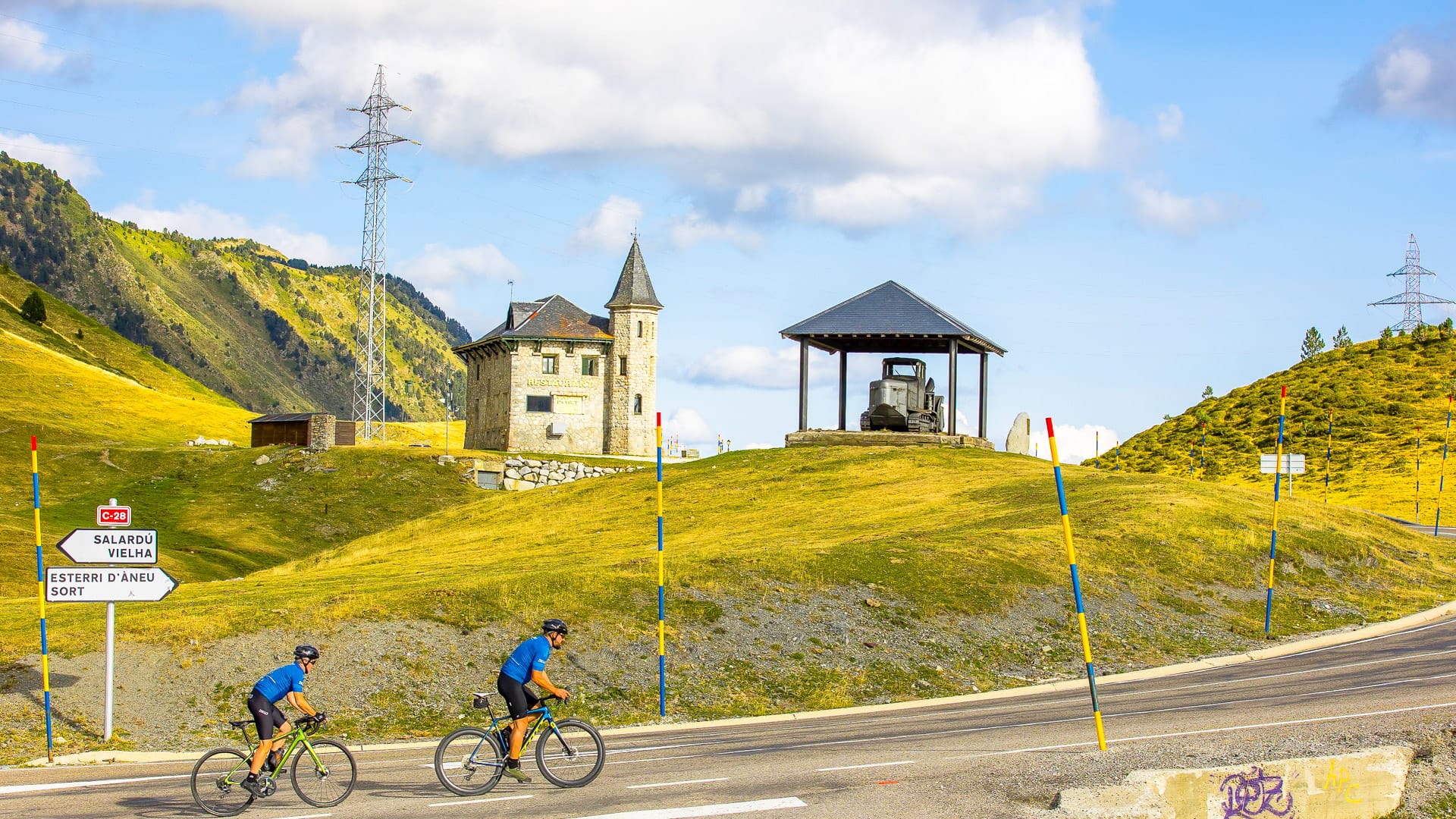
Port de la Bonaigua (photo credit: Ziklo Team (via Catalonia – Catalan Tourist Board))
What is the must-try food for cyclists in Catalonia?
After a big day on rolling coastal roads or Pyrenean passes, Catalan food hits the spot: simple, seasonal and made for hungry riders.
Think sun-sweet tomatoes, wood-smoked grills, olive oil with real character and bakery counters that never seem to end; great fuel before, during and after the ride.
Here are some options to try:
- Pa amb tomàquet: country bread rubbed with ripe tomato, olive oil and salt – the base of every good meal
- Botifarra or fuet: grilled sausage or cured salami, a salty, savoury recovery snack
- Escalivada: roasted peppers, aubergine and onions with PDO Les Garrigues olive oil
- Fideuà / suquet de peix: noodle or fish stews for a coastal feast
- Calçots: flame-grilled spring onions with romesco
- Alt Urgell i la Cerdanya cheeses & butter (PDO)
- Coca: flatbread/pastry – sweet or savoury
- Esqueixada: shredded salt-cod salad
- Crema Catalana or Agramunt torró (PGI)
- Lleida pears (PDO) and Catalan Rural Bread (PGI)
And to drink:
- DO Costers del Segre wines
- Cava from Penedès
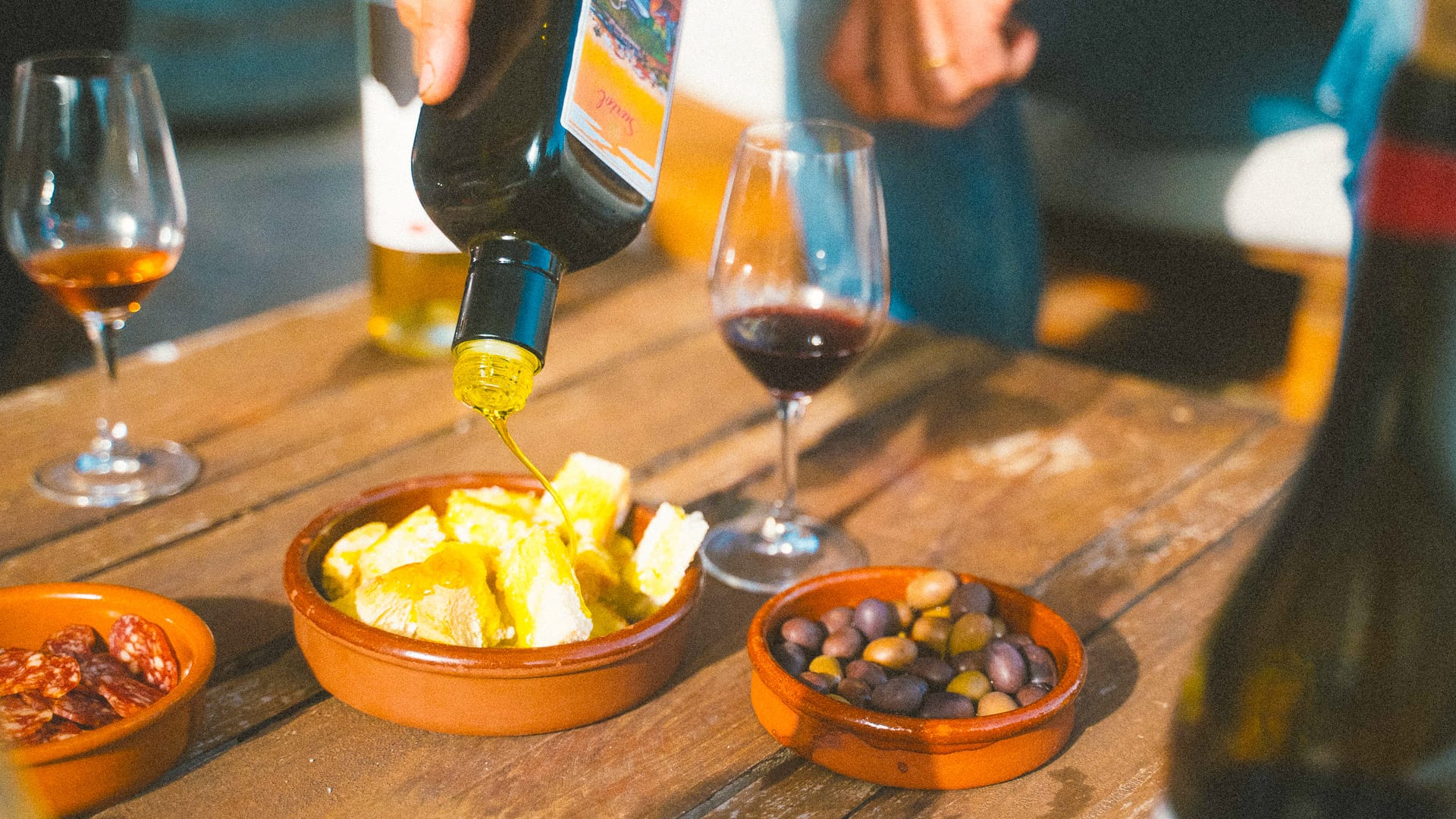
Tapas and wine (photo credit: Rafa Perez via Catalonia – Catalan Tourist Board)
Do you need to speak Catalan?
No, but a little often goes a long way. Most people speak Catalan and Spanish, and you’ll get by in English in cities and bike hubs like Girona. In rural areas, you’ll find less English, so a few basics help and are warmly received:
- Bon dia / Bona tarda / Bona nit (good morning/afternoon/night)
- Si us plau / Gràcies (please / thank you)
- Un cafè, si us plau (a coffee, please)
Do you need to hire a car?
Not necessarily. If you base yourself in Girona or Barcelona, you can ride from the door and use trains to hop to coastal starts or hill ranges. More on that below.
A hire car helps when you want:
- Quieter bases (e.g. Lleida towns, or remote Pyrenees climbs) with minimal public transport.
- One-way routes/early roll-outs without train timetables.
- Family logistics or lots of kit.
Are bikes allowed on public transport?
In Catalonia, local and regional trains (Rodalies/Regionals and FGC) generally accept bikes, with common-sense limits on numbers and a preference for off-peak times. Barcelona’s Metro and Trams allow bikes at quieter times and all day on weekends/holidays; look for designated areas for bikes.
For high-speed services (AVE/OUIGO), you usually need the bike bagged/folded and within a size/weight limit; some routes require a reservation for bikes – check when booking. Long-distance coaches may take bikes in the hold if pre-booked and packed (wheel off, padded), but policies vary, so always check in advance.
Top tips! Travel off-peak, arrive early to board first, use a soft bag or cover, remove the front wheel/pedals if needed, carry elastic straps, and keep a microfibre cloth to avoid leaving tyre marks. Always check the specific operator’s rules before you go.

Clare admiring the beautiful Lake Banyoles
Part 5: Where can cyclists find out more about cycling in Catalonia?
Catalonia is a cyclist’s dream: sunshine, lively café culture and routes for every level. Mix scenic coastal rollers with legendary Girona cycling climbs, or head in search of the quiet Lleida countryside and Tarragona’s vineyard backroads for low-traffic miles and lesser-visited landscapes.
Ready to plan? The Catalonia – Catalan Tourist Board website is packed with practical, up-to-date advice for travel-loving cyclists, including where to stay, what to ride and how to make the most of Catalonia cycling tours. Dive in to start plotting your cycling trip.
This guide also draws on multiple trips I’ve made to the region; you’ll find plenty more detailed articles and ride guides below for extra ideas, route intel and first-hand tips to fuel your Catalan cycling escape.
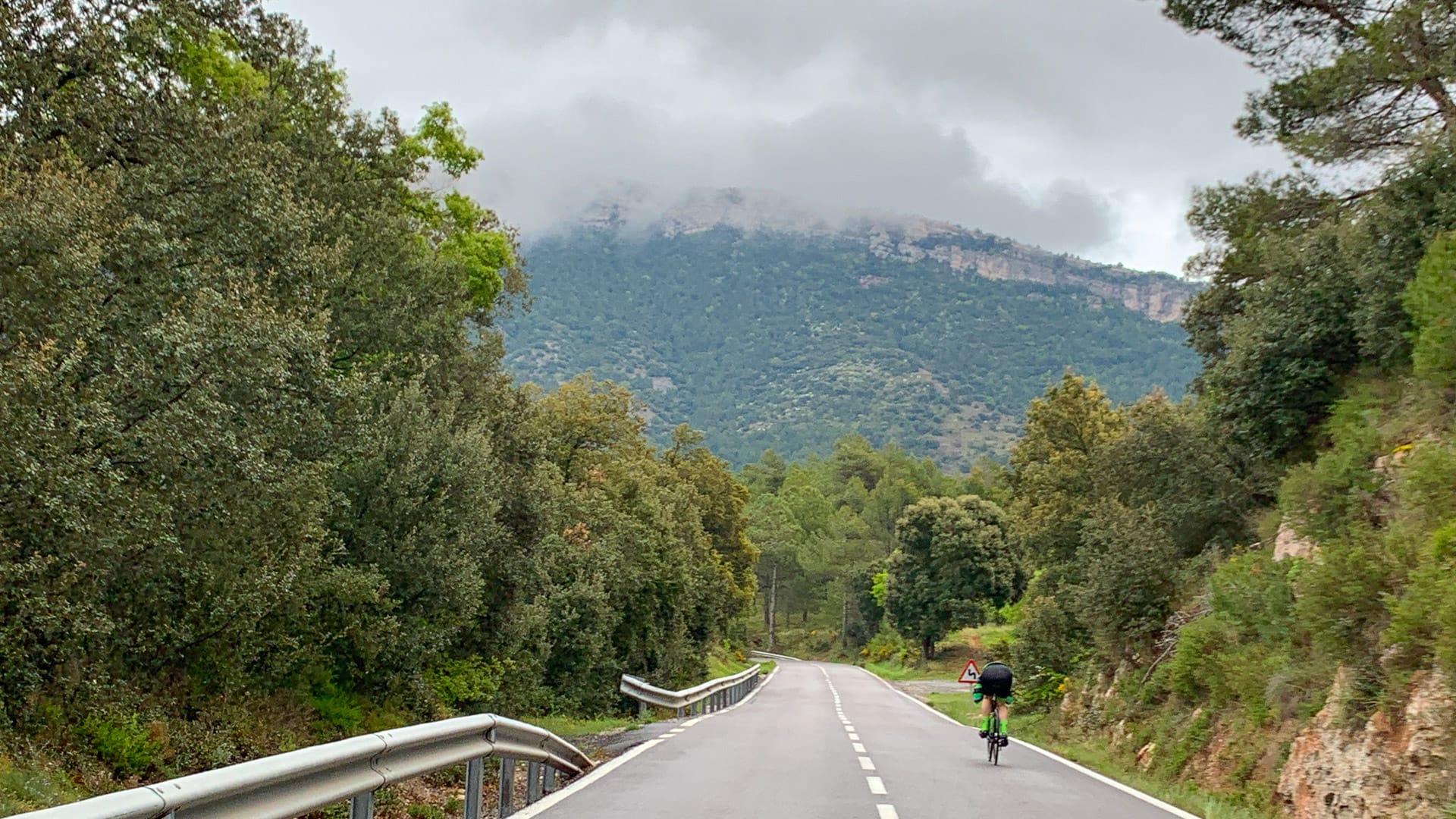
Tarragona mountain road
How can you discover more about Catalonia?
Have you been cycling in Catalonia? Perhaps you have already experienced the legendary Girona cycling routes and are seeking more ways to experience this wonderful destination by bike? We’d love to hear from you! Leave us a comment below.
Looking for more cycling inspiration in Catalonia? Don’t miss:
- Guide to Barcelona
- Guide to Girona
- Guide to Lleida
- Guide to Costa Daurada
- Guide to Terres de l’Ebre
- Best Girona cycling climbs
- Gravel cycling in Girona
- Where to stay in Girona
- Easy cycling routes in Girona
- A 72-hour cycling holiday in Girona
- Girona bike tours: which to choose?
- 10 handy tips for Girona (Spain) cycling
- Cycling in Andorra
Got a question for Clare?
Fill out this form and we will send it to Clare. We aim to get you an answer within 24 hours where possible!First Published: 28 October 2025
The contents of this website are provided for general information purposes only. It is not intended to amount to advice and you should not rely on it. You should carry out your own due diligence and risk assessments and take professional advice. Views expressed by interviewees or other users of this website do not necessarily represent our views. We make no representations, warranties or guarantees, whether express or implied, that the content on our website is accurate, complete or up to date. If you use any information or content on this website, download from, or otherwise obtain content or services through our website, it is entirely at your own discretion and risk. Epic Road Rides Ltd disclaims all liability and responsibility arising from any reliance placed on the information and content on this website. Find out more here.

